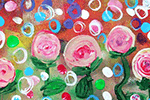The Children's Art Book
Drawing & Sketching for Children
Parents who focus on academic excellence in schools use drawing as an avenue for children to practice thinking, feeling and expressing, so that their child will learn to understand and know the world around them, and how to represent their ideas visually. In recent decades, heavier importance is accorded to allow children to develop their imagination, creativity and confidence – independently.
Giving your child the freedom to draw allows stories to tell, pretend plays and unique personalities to evolve.
So, how do we approach teaching drawing to children? There are many ways to go about doing it, and not just one right way.
First things first – Managing the parent’s expectations
- Don’t expect instant results. Learning to draw involves a multitude of skills: motor, observation, expression, etc., and these skills take time and practice. Having unrealistic expectations on a child may discourage them or even deter them from exploring. Be encouraging, and let them take the lead.
- Be positive. Listen, then offer. Parents look out for their children. It’s natural and that’s what parents do. But avoid correcting drawings too quickly. Observe your child, and ask questions about their drawings. Be positive, and offer possibilities rather than imposing. Allow them to own their drawing.
In lives constantly controlled by parents, allow art to be that one avenue of true freedom for children, filled with imagination and possibilities, guided by their interests and abilities. Join your child in their world and stories, instead of having them live in yours.
Remember, learning depends on what stage of development the child is at. Every child’s learning journey is different.
Developing children’s love for drawing
Children who love drawing will find anything related to pencils and sketching fun, enjoyable and natural. Here are some ideas to encourage and nurture a child’s love for drawing from young.
- Make drawing supplies readily available. Have a drawing kit stocked well with pencils, coloured pens, markers, chalk or anything that can be picked up and used immediately. Stash drawing paper (coloured, recycled, hand-made and all) in different corners of the house, to catch that drawing spark when it happens!
- Everything is a stencil. Use cup footprints as circles, spoons as ovals or straws connected as triangles! Children who are used to utilising their environment for creative uses will begin to see their world differently, where every object can offer a line, a bend or a shape.
- Bring a sketchpad, wherever you are! Each time your kids see or experience something new, draw them out! Practice sketching quickly. Sketch on a bus ride, or at the picnic. Create plenty of opportunities to observe and even to practice memory skills! Encourage children to draw more than just their favourite Disney characters.
Choosing drawing themes. What to draw?
Children of most ages respond when drawing their favourite cartoons and stories. To get them to draw then, make up a story, tell and draw as you go along! Be playful and ask questions to build characters in the story. “How old is the Elephant?” “Is the Elephant alone? Or with family?” Children always love a whacky tale, so twist the story around and make Elephant a Super-Elephant that can fly!
Draw a story filled with characters with friends, hobbies and favourites! Be playful with names, size and looks, and prompt questions that encourage uninhibited imagination!
As enticing it may be to continue building characters of the story, it is important to give context by working on the background. Draw in the safari that the Elephant roams around, complete with footsteps on the green mud fields that lead Elephant into the next drawing where it meets the greatest villain of all, Robot-Monkey Invite siblings, cousins and friends to contribute their own drawings to tell the story!
When story drawing, consider the possible age appropriate themes and difficult levels.
Babies & Toddlers: Basic is Best
At this age, go for simple shapes and basic details. Celebrate and make every stroke fun for babies and toddlers! Avoid erasing or correcting mistakes, instead praise and point out how they recognise and draw relationships from their favourite books!
Work on ways to connect specific shapes and lines into a recognisable figure. Try simple faces. Encourage the young ones to add their own details. A wide open smile with a cheeky tongue, or a whimsical clown’s ball-y nose. Don’t bother with wavy ears for now, toddlers get so amused when you draw bunny ears on faces!
Use as many colours as you can, and with the proper names. Colouring in the faces will be messy and incomplete, so skip it for now and drawing models with coloured pencils or markers to depict colours instead.
Preschoolers: Build & Expand the Vocabulary
Just as you broaden your child’s vocabulary of written words, you can do the same for visual images – by introducing, then relating and using them in daily life.
Show a child how to draw something, such as a bird. Observe how your child draws, and begin asking questions to offer possibilities in building the story. “How many wings does the bird have? Where is the bird flying to? How fast can the bird fly?”
Offer suggestions to add details that create energy or depict movement and action. “Try adding trails behind stars to show which direction the stars are flying towards” “Add beads of sweat trickling down the face to show how tired the boy is after the race.” Provide the basic steps to draw something, then develop the eye and habit for creating variations.
Children at this age are especially vocal about what they see and do in preschool. Spend time drawing with your child about things in your life – a day in school, a visit to the zoo, a recent family birthday celebration. Work through the emotions of your child during these events and allow these emotions to be expressed through the drawings.
School Goers: Grow & Build Skills
Just as children begin Primary school, they would have become comfortable and confident with their fine motor control, can observe a recognise objects around them well, and are interested in creating complex shapes and objects. They are also vocal in their drawing preferences and ready to take up the challenge to draw what they see. This is when they begin to draw realistically.
A word of caution: Realism is one of many aspects of artistic expression, and should be balanced with expressive experimentation and exposure to art movements, classical artworks, famous styles of art masters etc.
The traditional strict copy-and-draw exercises are generally a very poor way to learn how to draw. Showing a child how something is drawn creates the first imprint of how to represent that object. Singapore parents are a varied bunch.
Some parents want their children to draw as you see in story books, while others hope for their children to draw anything but what is in story books.
Generally, avoid showing a child how to draw something, or drawing on a child’s paper.
Tactile Tracing Practices. Instead, try tactile tracing – a method of observing an object by running your finger along the edge of the object, while not looking at the paper. This encourages children to study the object, animal, person, vehicle or what is being drawn by observing its shapes and contours, and representing it the same lines and waves in a different fashion, length, perspective and dimension.
Such observational practices encourage children to own both the process and product, and eventually build enough skills and confidence to draw anything they like, any way they like.
Drawing Beyond Observation. With the increased awareness from the inter-disciplinary knowledge acquired in school, children begin developing interests in social and cultural affairs, such as nature protection and animal treatment, world peace and inequalities, and environment conservation. They also begin to love incorporating their personality into design – from houses, to clothes, to cars and consumer products. Children are now often able to use drawings to tell stories from their memories, or wishes for the future. Many children at this age are constantly learning creative thinking skills from observation, imagination, inventing and designing.
Summary
Whether your child’s medium is branches and twigs on sand or chalk on a blackboard (hopefully not oil pastels on the wall!), few activities come as naturally to children as drawing. The benefits of drawing are so much more than the remote possibility children could one day be professional artists.
Ultimately, what may be most revealing about your child’s art isn’t the art itself, but what the children say or does during the process. Our children’s drawings can tell stories that offer a unique perspective into their world than does the final product.











